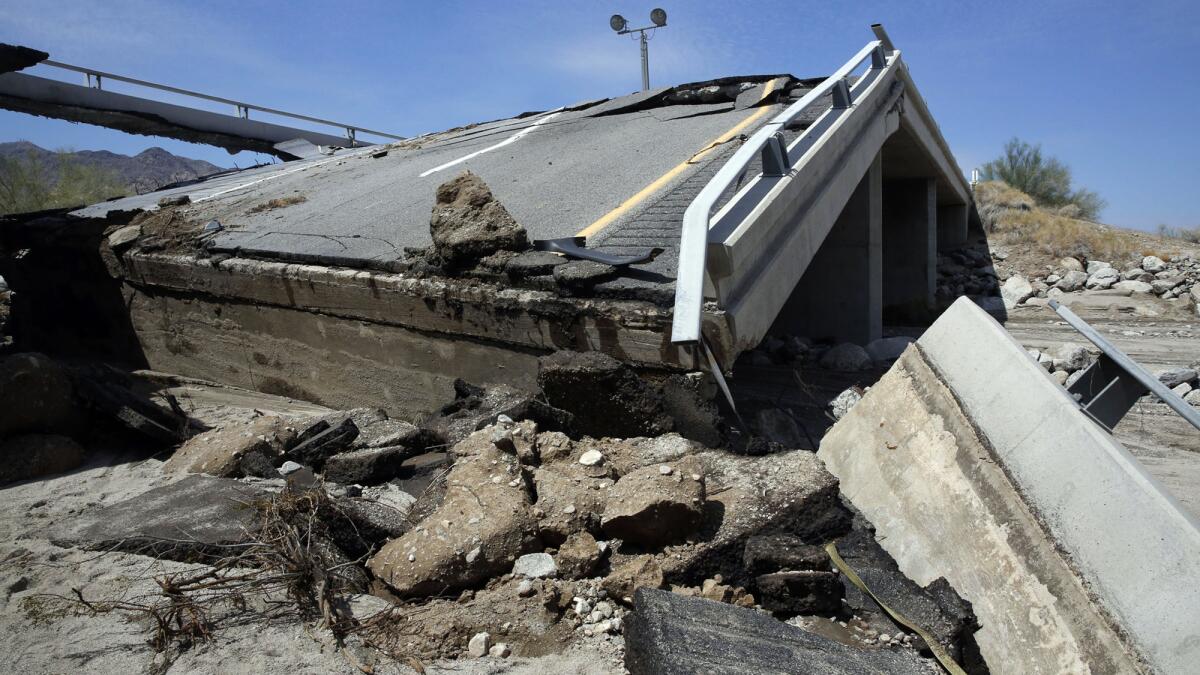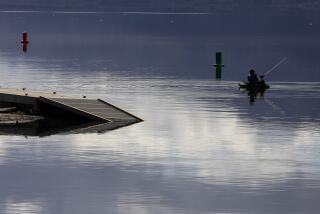Unusually strong July rains offer a preview of a robust El Niño

The eastbound bridge of Interstate 10 between Coachella and the Arizona border lies in ruins after yesterday’s flash floods washed out the bridge over a desert wash. Traffic in both directions of the major east-west highway has been stopped indefinitely while engineers assess the damage.
A washed-out bridge on Interstate 10 that cut off a vital shipping route with Arizona, mudslides in Moreno Valley and snarled Southern California freeway traffic from heavy weekend rain is only a preview of problems that could come with a strong El Niño this winter, forecasters say.
The weekend storm that washed over the region Saturday and Sunday was not only remarkable for its timing -- July rain storms are rare events in Southern California -- but for its strength, the National Weather Service said.
More than a dozen local rainfall records were broken over the weekend, the weather service reported, and more rain was forecast for Monday.
SIGN UP for the free Essential California daily newsletter >>
The El Niño phenomenon that has warmed Pacific waters has apparently laid out a welcome mat for tropical storms to creep north, closer to the California coast than during normal years, allowing for systems such as Tropical Storm Dolores to bring muggy, rainy weather to the West’s parched landscape, said Stuart Seto, an National Weather Service specialist.
“Even though Dolores is a pretty good wake-up call for us, we should start preparing for late August or early September,” Seto said, saying that’s when the region could see more sustained rains.
After that comes California’s traditional rain season, which begins in October. A strong El Niño could mean significant relief from the state’s unrelenting drought, Seto said.
But while a heavy rain season could spell long-term relief for California’s landscape, it would test Southern California’s infrastructure. On Sunday afternoon, a creek in Desert Center between Coachella and the Arizona border was overwhelmed and washed out a bridge on the 10 Freeway.
The road buckled and collapsed, cutting off one of the state’s vital truck shipping corridors for weeks or, more likely, months. On Monday, Caltrans began inspecting other bridges in the rain-soaked area and found a second one susceptible to collapse.
Meanwhile in Moreno Valley, about a dozen homeowners were working to clean up their properties after rock and mudslides sent tons of earth downhill.
July rain is so unusual in Southern California that the storm broke a number of records for the month. The 0.36 inch that fell in downtown Los Angeles on Saturday set a record for the most rainfall in July, surpassing the quarter-inch that fell in July 1886, said National Weather Service meteorologist David Sweet.
“July is typically the driest month of the year,” weather service meteorologist Scott Sukup said Sunday. “To have that much rain yesterday and another significant storm today is pretty unusual. ... For July it’s historical.”
In Orange County, a debris flow stranded several residents in Silverado Canyon on Sunday evening.
“We had a pretty significant mud and debris flow that went into the creek and then across Silverado Canyon Road, making the road impassable,” said Orange County Fire Authority Capt. Steve Concialdi.
The debris flow, in the Smisek Ranch area, is “about 300 feet long, around 3 feet deep and 4 to 5 feet wide,” Concialdi said, and residents are unable to get out.
“We had a 1,000-acre brush fire back in September, so we have a pretty large burn scar,” he said. “So when we do have significant rain, that mud and debris come downhill toward the road, toward homes.”
No homes, however, were at risk, Concialdi said.
In San Diego County, the hardest-hit area was in rural Ramona east of Escondido, where streets flooded, several cars were half-submerged, and some homes were flooded Saturday.
The worst of the storm was believed to have passed Sunday and drier weather was predicted by mid-week, the weather service said.
Los Angeles Times staff writers Tony Perry and Tony Barboza contributed to this report.
Hoy: Léa esta historia en español
For more breaking news, follow @JosephSerna, @japanzar and @raablauren on Twitter.
ALSO:
Passage of California climate change bill could set global example
Shrinking Colorado River is a growing concern for Yuma farmers — and millions of water users
Survival of Chatsworth Reservoir’s ‘ecology pond’ is debated
More to Read
Start your day right
Sign up for Essential California for news, features and recommendations from the L.A. Times and beyond in your inbox six days a week.
You may occasionally receive promotional content from the Los Angeles Times.









